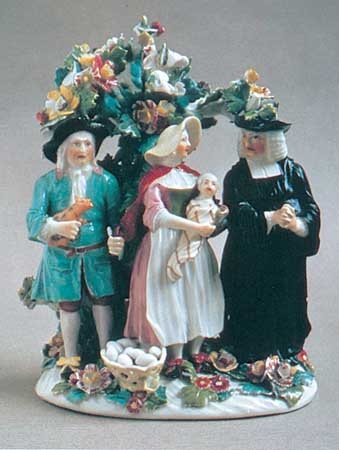Derby ware
pottery
 porcelain figures and servicewares made in Derby, central England, about 1750–1848. The best-known early figures were characterized by glaze retractions about the base. Known as “dry-edge” figures, their modeling and execution were excellent, the porcelain soft and heavy; a pair known as the “Florentine Boars,” after Italian bronzes, is the most noted example.
porcelain figures and servicewares made in Derby, central England, about 1750–1848. The best-known early figures were characterized by glaze retractions about the base. Known as “dry-edge” figures, their modeling and execution were excellent, the porcelain soft and heavy; a pair known as the “Florentine Boars,” after Italian bronzes, is the most noted example.In 1756 William Duesbury established another factory at Derby. Advertising itself as “the second Dresden,” it produced finely modeled, palely coloured figures often imitative of Chelsea (with which it was often confused) and Meissen wares. Flowers and colourful insects were favourite decorations of the serviceware. After Duesbury purchased the Chelsea works in 1770, a design trend away from Rococo porcelain toward the Neoclassical began; during the last decades of the century the painting of the wares achieved a marked excellence, while the unglazed (biscuit) figures, some based on those produced at Sèvres, France, became the most delicate and expensive of the Derby wares. Duesbury died in 1786; in 1815 the factory was leased, and about 1845 many of the molds were sold. In general, the 19th-century works were inferior to those produced earlier. The modern Royal Crown Derby factory dates from 1875.